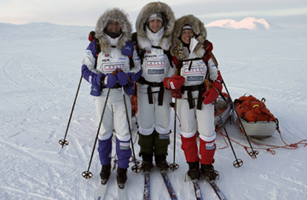
Scientists know that global warming is thinning the Arctic ice cap. They're just not sure how fast. Some researchers think there could be ice-free summers at the top of the world within four years; others say it'll take a century. The reason those forecasts are poles apart? While satellites can show the total area covered by sea ice, relatively little is known about the ice's thickness — essential information if you want to calculate volume.
So in February, three British explorers set out from northern Canada to gather data that will help scientists assess how much ice is left, and when it will disappear. During their 73-day, 270-mile (434 km) trek, Daniels, Hadow and Hartley took 1,500 measurements of sea-ice thickness and recorded 16,000 observations on everything from snow distribution to the size of cracks in the ice. "[Explorers have] mapped the world's surface," says survey leader Hadow, 47. "The next phase is getting to places that are too hazardous for standard scientific operations and extracting raw information."
Even for an Arctic veteran like Hadow — in 2003 he became the first person to trek from Canada to the North Pole without resupply — getting that information would prove unexpectedly arduous. A portable, ice-penetrating radar designed to measure density and depth failed in the expedition's first few days, forcing Hadow and Hartley to collect measurements by boring holes in the ice with a hand-powered drill. They would spend up to five hours a night drilling in temperatures as low as -94°F (-70°C). But, says Hartley, 41, a seasoned polar photographer, "we were motivated by the knowledge that every measurement would be appreciated by a scientist sitting at a desk somewhere."
Just how risky an expedition the Catlin Arctic Survey team (named for its insurance-firm sponsors) had taken on became clear on the third night. At 3 a.m., the trio were jolted awake by a loud crack — the sound of the ice breaking up around their tent. "It was terrifying," says Daniels, 45, one of the world's leading polar guides. "You only have one option: move out of the way." In the dark, they shifted to a 2-ft.-wide (0.6 m) spot where the disintegrating pan met a steadier floe. By the morning, says Hadow, "the rugby-pitch-size pan we'd been camped on had broken into pieces the size of Ping-Pong tables."
Crossing the hostile Arctic terrain took a heavy physical toll on the team. Hartley shed 35 lb. (16 kg), and almost lost a big toe to frostbite. Hadow and Daniel's feet and hands suffered temporary nerve damage from the cold. But their sacrifices are paying off for scientists around the world. "This is up-to-date data that will help fill gaps in our understanding," says Wieslaw Maslowski, an oceanographer at the U.S. Naval Postgraduate School in Monterey, Calif., who is combining the team's numbers with information from satellites and submarines to develop more accurate melt projections. A report on the expedition's findings will be handed to global leaders at December's U.N. climate-change conference. And Hadow plans to return to the Arctic in 2010 — this time with a functioning radar that will harvest millions of measurements. "There's a sense of unfinished business," he says.